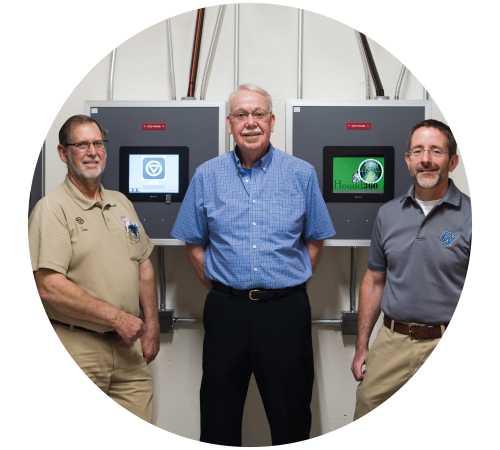The invention is called CO2 Hound and it’s an advanced sensor technology that can improve efficiency in heating, ventilating and air conditioning (HVAC) systems.
Normally, HVAC systems blow either heated or cooled air into a room based upon a thermostat reading. CO2 Hound makes the process more efficient by also measuring the amount of carbon dioxide in the air being returned to the system, and making adjustments to the air being sent back into the room.
The product inventors came up with the idea when they had trouble controlling the temperature in a lecture hall, and thought finding a more efficient way to handle the volume of outside air could be impacted by CO2 levels in the room.

The inventors (from left to right) Tom Michalak, Leo McCormick and Sean McManus stand in front of the CO2 Hound sensor panels in Finkelstein Hall.
According to Tom Michalak, an energy engineer for Facilities Services and one of the inventors of CO2 Hound, the efficiency comes from having more information. When a room is solely controlled by the thermostat, outside air, which by nature must be heated or cooled for comfort, must be brought to the room temperature. However, if air quality is still at an acceptable level, rather than using energy to heat or cool outside air, CO2 Hound can tell the HVAC system to recirculate the air back into the room. That means energy is only being used to heat or cool when air quality requires fresh outside air.
Michalak said checking the quality of the air informs how much outside air is needed.
“This allows our buildings to operate and respond to temperature needs in a faster, more efficient way,” Michalak said.
Sean McManus, another GVSU energy engineer and inventor, said the concept is based on what he called “demand control,” in which the right level of air going into a room can result in up to 25 percent energy savings.
The new system is also more data-friendly, reporting back more information to engineers compared to previous analog systems.
The invention has such promise for energy savings that the university has licensed the technology to a Grand Valley graduate who is in the process of building a company to commercially market and sell the product publicly. Grand Valley earns revenue from the agreement and the inventors earned royalties.
Leo McCormick, also an energy engineer and the third inventor of the product, said CO2 Hound has been patented and is another way for the university to do good in the world.
Grand Valley is currently using the system in more than a dozen buildings and retains the rights to continue installing the system in new buildings and retrofits.
Adam Donovan is the alumnus who purchased the licensing rights from the university. He plans to market the technology as “Hound360” through his newly created company, Antrum.
“The potential for this technology is huge,” Donovan said. “As I was vetting the tech, I thought it was a really good idea. The system lets you right-size the HVAC system in any facility, and you can do all of that not at the expense of indoor air quality.”






